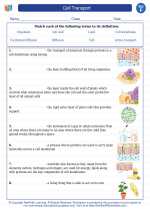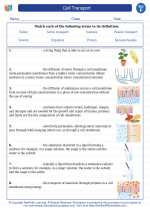Cell Transport
Cell transport refers to the movement of materials across the cell membrane. The cell membrane is a semi-permeable membrane that allows certain substances to enter and leave the cell. There are two main types of cell transport: passive transport and active transport.
Passive Transport
Passive transport does not require the cell to expend energy. It relies on the natural movement of molecules from an area of high concentration to an area of low concentration. There are three main types of passive transport:
- Diffusion: The movement of molecules from an area of high concentration to an area of low concentration. This occurs until equilibrium is reached.
- Facilitated Diffusion: The movement of specific molecules across the cell membrane with the help of transport proteins.
- Osmosis: The diffusion of water molecules across a selectively permeable membrane.
Active Transport
Active transport requires the cell to expend energy (usually in the form of ATP) to move molecules against their concentration gradient, from an area of low concentration to an area of high concentration. This process is carried out by specific proteins in the cell membrane.
Study Guide
Here are some key points to remember about cell transport:
- Understand the concept of selective permeability of the cell membrane.
- Be able to differentiate between passive transport and active transport.
- Know the different types of passive transport: diffusion, facilitated diffusion, and osmosis.
- Understand the role of transport proteins in facilitating the movement of molecules across the cell membrane.
- Be familiar with the concept of concentration gradients and how they drive the movement of molecules.
- Recognize the role of ATP in powering active transport processes.
Remember to review and understand these concepts thoroughly in order to have a solid understanding of cell transport.
.◂Science Worksheets and Study Guides Sixth Grade. Cell Transport

 Worksheet/Answer key
Worksheet/Answer key
 Vocabulary/Answer key
Vocabulary/Answer key
 Vocabulary/Answer key
Vocabulary/Answer key
